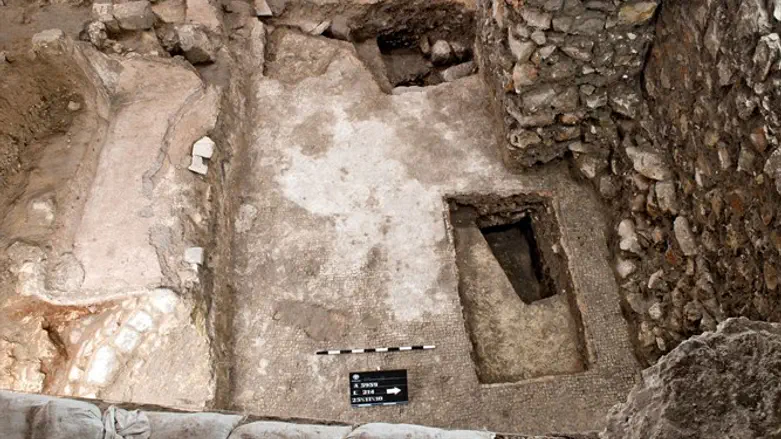
In just a few days, a mikvah (spiritual purification pool) will open in the Jewish Quarter of Jerusalem's Old City, after ten years of construction. Arutz Sheva heard from Ephraim Holtzberg, a local, the incredible story about how an ancient bathhouse of the Roman Tenth Legion was discovered beneath the mikvah.
"God granted me the gift of being among the first in the Quarter's yeshiva," Holtzberg began his tale. He described how in the early '80s, when he first came to live in the Jewish Quarter after his marriage, he saw that there were only two tiny mikvahs in the area, one for men and one for women. He felt that the growing community deserved a bigger and better mikvah.
He turned to the religious council, who told him that if he could purchase the property, they'll do the rest, and so it was.
Holtzberg bought a plot around 1,000 feet squared on Haomer Street. However, any construction area in Israel must first undergo an archaeological inspection, to make sure nothing of historical importance would be destroyed in the process. When the Antiquities Authority representatives arrived, they were surprised by the results of their investigations.
On the spot, the discovered a Roman bath house. The team dug up remains of a clay pipe, mosaics, and pottery, which bore the markings of the Roman Tenth Legion. The Roman Tenth Legion were responsible for the destruction of the Second Holy Temple, and the razing Jerusalem.
In accordance with an earlier agreement between the Jerusalem municipality and the Antiquities Authority, the remains were removed and the plot was certified to build the mikvah. Holtzberg sees the waters of the mikvah as the vengeance which will wash away the blood of the murdered Jerusalemites of two thousand years ago.
However, Holtzberg's story didn't end there. It turns out the Roman bath house was also built over an older site, a Jewish site. One year, while the mikvah was in construction, during an especially rainy winter, the contractors noticed the rivulets were running en masse to one point - where they disappeared.
"They followed the water, and discovered under the Roman bath house a massive cistern from the Second Temple era, which had been part of the Bethlehem aqueduct," Holtzberg describes the area, which was used to gather water for the Temple.
According to him, the resevoir was essentially a room, 645 square feet, covered in mosaic designs.
"When the Romans built their bath house, they required large quantities of water from the aqueduct and from rain water, and so built the bath house over the cistern."

In light of the new discovery, the contractors changed their plans for the mikvah, planning the structure around the ancient cistern. Holtzberg says that the mikvah will be opened to the public in the near future. He is just waiting for a final decision as to whether the mikvah will be dedicated for men or for women. He expects the chief rabbis of the Jerusalem to speed up the decision, and the opening of the unique mikvah.
As the conversation continued, Holtzberg told stories of modern living in the ancient city, while focusing on those he calls the "hidden righteous ones" discovered around the Western Wall.
Among these, he names a Bukharian beggar named Pinchas, who collects every week, and every Saturday night he waits at the bus station for the 1 line and pays the fares of some three hundred Jews who went to the Western Wall over Shabbat for prayers, and therefore weren't carrying money for a bus trip home.

He also told Arutz Sheva of a "'Peace in the Home' charity organization," established by Rabbi Uri Abritzer, which provided cakes and drinks for people who go to pray before sunrise after learning Talmud with the Rabbi of Heichal Shlomo, so they don't return home hungry and asking for breakfast from their wives at such an early hour. Thus, Rabbi Abritzer worked to create marital peace.
Holtzberg continued, and told of the special prayers of people who go specifically to pray at the Western Wall, including the Rabbi of the Old City Avigdor Nebenzhal. "These people are the salve of the destruction, with their unconditional love."